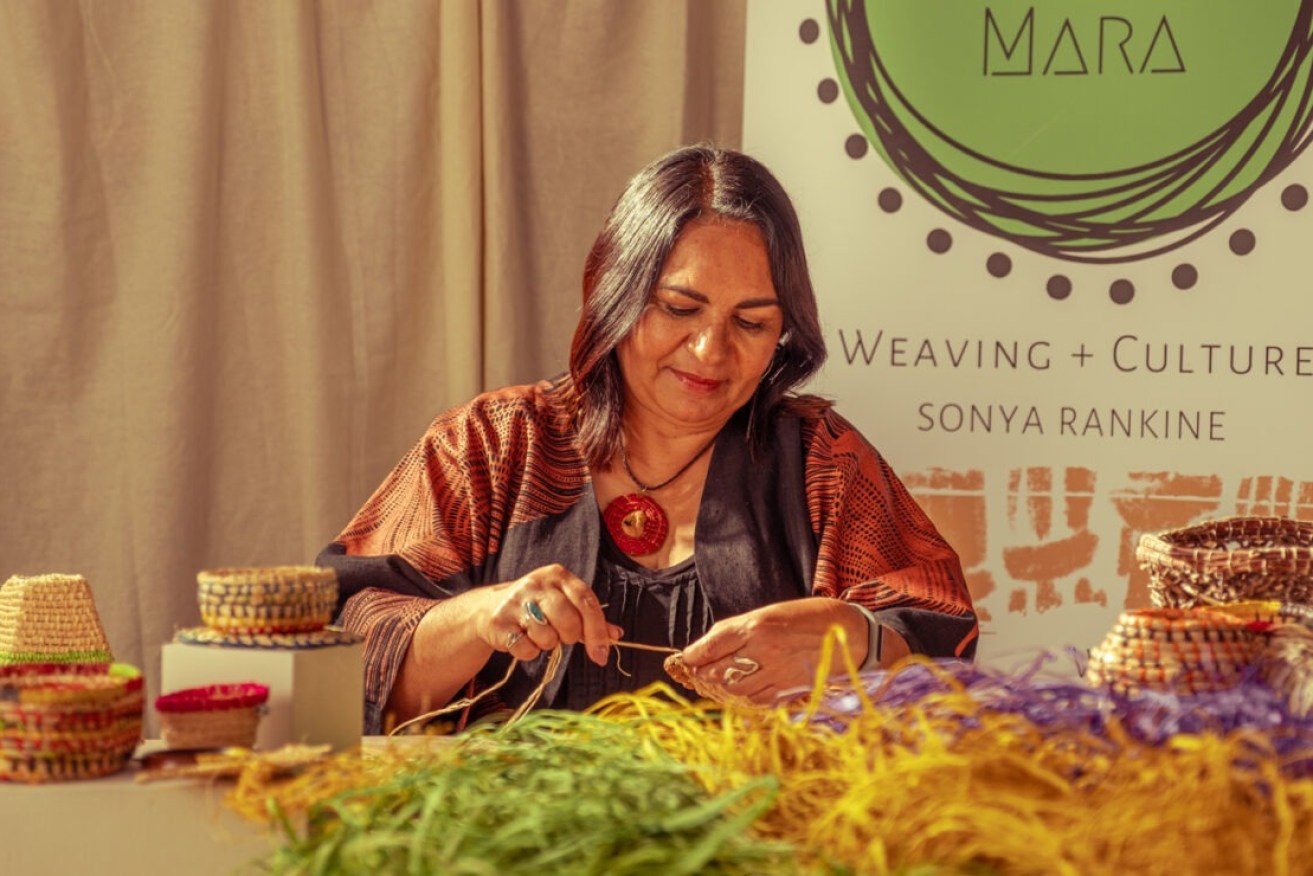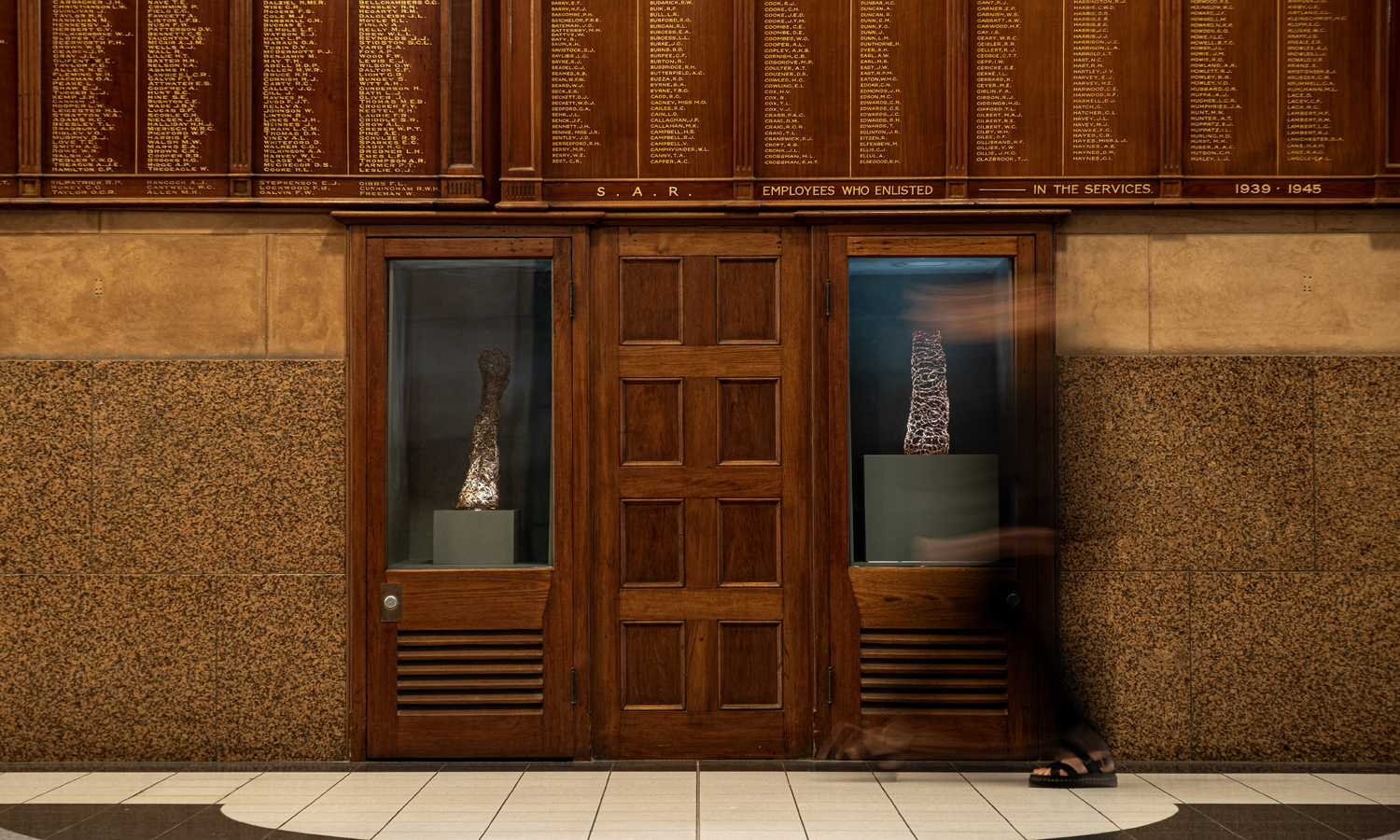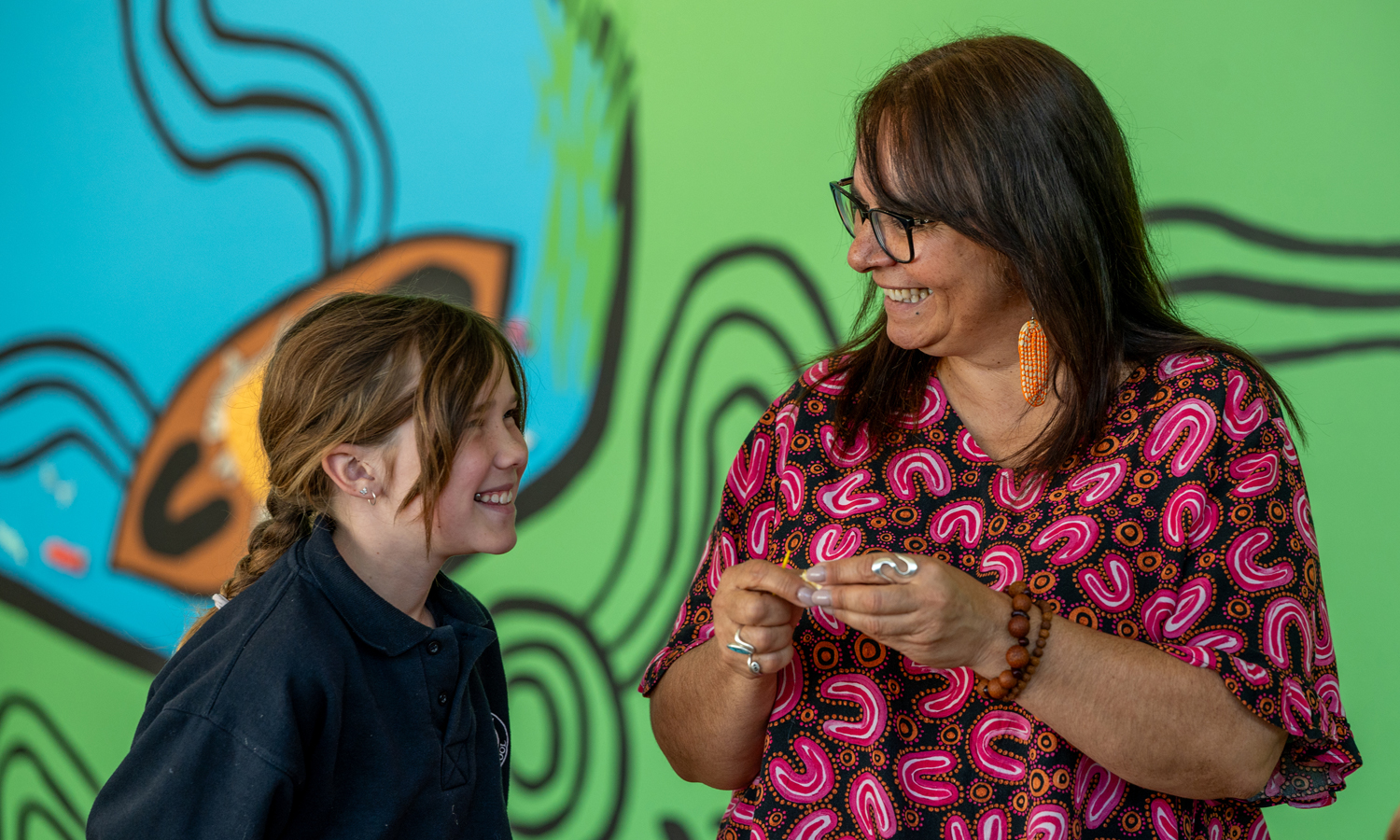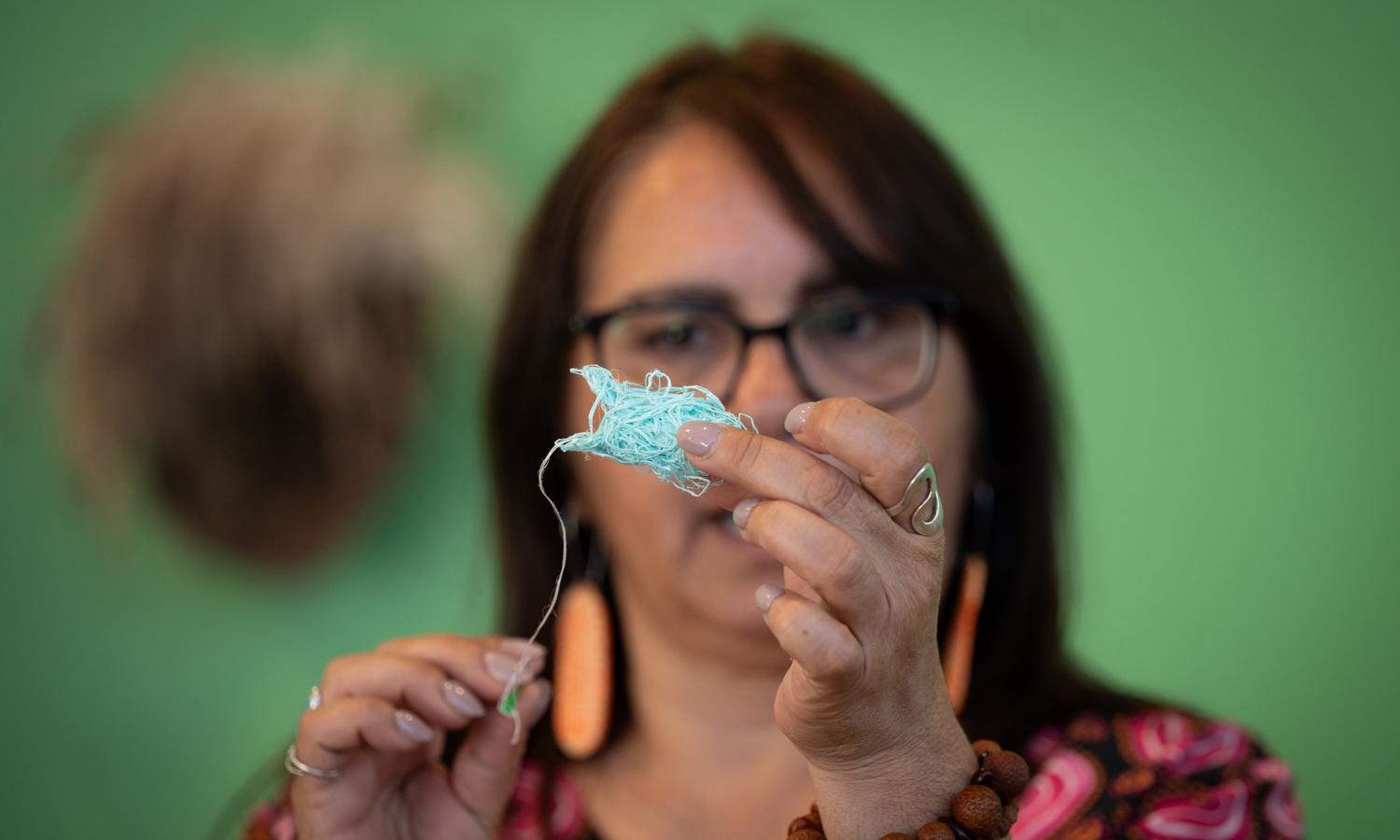In the Studio with Sonya Rankine
Sonya Rankine has woven traditional techniques and a passion for truth telling and creativity into a multi-faceted contemporary arts practice and business. Her latest pieces are lighting up the historic phone booths at Adelaide Railway Station.


Sonya Rankine presents a workshop in traditional Ngarrindjeri and Ngadjuri weaving techniques at JamFactory at Seppeltsfield. Photo: Connor Patterson, courtesy JamFactory
Sonya Rankine, a Ngarrindjeri, Ngadjuri, Narungga and Wirangu artist who is known for her intricate weaving practice, says she’s always been “arty and crafty”.
This is a clear understatement, as the multi-faceted creative explains her pursuits: weaving workshops, public art, a business, pottery, singing, and writing.
“It’s not that I necessarily get bored. I just like to experiment and have a go with new things,” Rankine says.
“Things just keep coming along and I just keep embracing it and enjoying being able to be an artist – something I’ve always really dreamed of.”
Rankine also doesn’t work in just one place: her “studio” is spread throughout her home in Moonta Bay, on Narungga Country.
There’s an office space with “bits and pieces and different materials”. In the lounge room, where she often likes to make jewellery, there’s a trolley full of creative supplies. Bigger pieces come together on the kitchen table – “the best worktable in the house” – where she sets up for days or weeks at a time.
“Anyone who comes over knows there’s no eating at the dinner table. It’s become the accepted norm,” she says.
And those works that are simply too big to even get down the hallway are completed under the carport out the front.
But there’s one element to Rankine’s practice that doesn’t exist within the boundaries of a single room, house or place.
“I always take weaving with me. I just always pack the things that are small and can all fit in a little snap-lock bag and off I go.”

Sonya Rankine wanted to learn traditional weaving techniques so she could then contemporise them. Photo: Connor Patterson, courtesy JamFactory
Rankine first came to weaving almost 30 years ago, at a community event where she saw Ngarrindjeri elder and master weaver Aunty Ellen Trevorrow.
“As a Ngarrindjeri person, I was just drawn to it because I wanted to learn that traditional practice of weaving,” she says.
The weaving traditions of the Ngarrindjeri people include that of everyday objects, like fish traps, eggs scoops and mats. Rankine – whose works include woven jewellery, baskets and wall pieces – finds inspiration in these origins of practicality, but also takes creative liberties.
“I wanted to learn traditional techniques that then I could contemporise,” she explains.
“I remember one time, I had nothing when it came to materials – absolutely nothing. But then I thought: plastic bags! I’ve got heaps of those!”
Rankine has enjoyed considerable success, including being named the NAIDOC SA Artist of the Year in 2021, winning the Don Dunstan Foundation Our Mob Emerging Artist Prize in 2019, and securing a 2022 Guildhouse and City of Adelaide Catapult mentorship (with ceramicist Helen Fuller).
The pursuit of contemporising tradition is exemplified in her current exhibition Spaces Between, which is being presented by JamFactory at Adelaide Railway Station as part of the 2023 Tarnanthi Festival of Contemporary Aboriginal and Torres Strait Islander Art.

Spaces In Between is being presented by JamFactory at Adelaide Railway Station. Photo: Connor Patterson, courtesy JamFactory
In Spaces Between, Rankine embraces a new way of weaving, focusing on the intersection of light and natural materials in a series of illuminated woven sculptures. Each work sits in a historic phone booth in the Railway Station.
“It was really about: How can I use this space to be a little bit more interesting? How can I challenge myself?
“I’ve played around with lights before, and I thought, what if we can focus more on shadows, and those spaces between that are created through the shadows.
“Working from there, I kind of went, oh, okay, well, reflecting on the shadow, let’s look at it being the space-between series, and how the light shines in the spaces between, just like life.
“There’s light that shines through from different angles, with many paths crossing in so many ways.”
This sentiment sits poignantly in phone booths that once connected people from near and far in the hub of public transport in Adelaide – spaces where people on divergent routes cross paths.

Sonya Rankine, Nganawi pulgi – My home and Ngopun pulgi – Going home, part of Spaces In Between at Adelaide Railway Station. Photo: Connor Patterson, courtesy JamFactory
Rankine’s projects and passions, in all their different forms, come together in her business Lakun Mara, which means “Weaving Hand” in Ngarrindjeri language.
“Lakun Mara is weaving plus culture,” says Rankine.
“Weaving is the core and was what created the birth Lakun Mara, but it’s grown to incorporate all the things that I’m artistically connected to.”
Alongside the workshops and the exhibitions – such as the recent Thukeri exhibition presented at the Adelaide Festival Centre’s Children’s Artspace and including works made in collaboration with children and families – this also includes recent involvement with the upcoming Adelaide Festival production Guuranda. For the new theatre work, Rankine translated songs written by director Jacob Boehme into Narungga.
“I’m also a singer, songwriter and poet, and I dabble in that when I can,” she says.

Sonya Rankine during a weaving workshop conducted as part of the Thukeri exhibition at the Festival Centre’s Children’s Artspace. Photo: Naomi Jellicoe, courtesy Adelaide Festival Centre
The one element that underpins all Rankine’s creative pursuits is truth telling, making it impossible to separate family ties, culture and Australia’s history from her work.
Through her journey of learning the tradition and art of weaving, and learning and teaching language, the artist says she’s participated in the act of cultural preservation, helping to restore aspects of her history that were impacted through colonisation.
“Continuing the revival of the cultural practice and the cultural maintenance of it is important to me,” she says.
To continue to revive, preserve and speak the truth, Rankine uses her art as a mechanism for sharing greater knowledge.
“I always say to people, ‘If you’re just coming to learn weaving, and that alone, you’ve come to the wrong workshop’.
“One thing that I consider to be incredibly important is to give people a cultural history: how invasion and colonisation has impacted on First Nation peoples. Really giving that strong message that we’re resilient. We have endured so much.
“People need to know this stuff. I try to do my bit in a in a way that I think that is honest and unapologetic.”
Sonya Rankine: Spaces In Between is being presented by JamFactory at Adelaide Railway Station until January 22. Find out more about Rankine’s Lakun Mara business here.

Rankine is passionate about continuing the revival of cultural practices. Photo: Naomi Jellicoe, courtesy Adelaide Festival Centre
In the Studio is a regular series presented by InReview in partnership with not-for-profit organisation Guildhouse. The series shares interesting stories about South Australian visual artists, craftspeople and designers, offering insight into their artistic practices and a behind-the-scenes look at their studios or work spaces. Read our previous stories here.
The Catapult mentorship program provides creative professionals with funding and support to develop their artistic practice through a meaningful mentorship. It is supported by donations from the Guildhouse Creative Champions, who have an opportunity to meet with Catapult artists, attend behind-the-scenes events, and experience their success as their careers grow. Become a Creative Champion or find out more here.
This article is republished from InReview under a Creative Commons licence. Read the original article.
InReview is an open access, non-profit arts and culture journalism project. Readers can support our work with a donation. Subscribe to InReview’s free weekly newsletter here.
![]()




